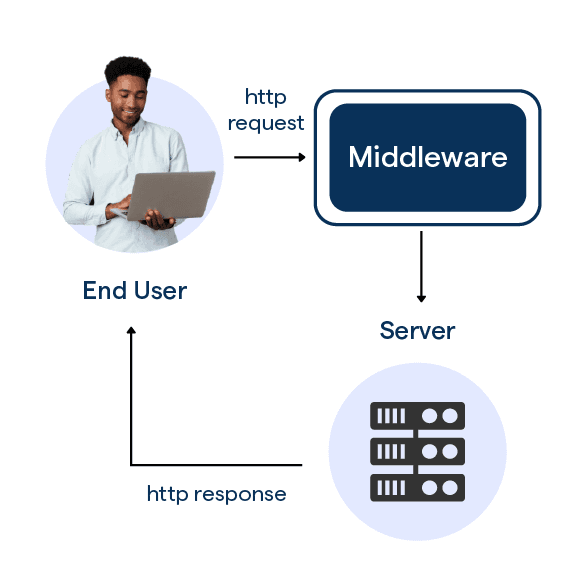What is Middleware?
Middleware is the layer of software that lies between the operating system and applications. It enables communication between different software applications and ensures that they work together and can share data. Middleware provides an abstraction layer for developers, so they can focus on the business logic of their applications instead of the complexities of the underlying system.
How does Middleware Work?
Middleware acts as a bridge between different software components. It provides an interface and translates requests and responses between different applications using predefined protocols. Middleware can be divided into multiple layers and components, such as message-oriented middleware, object request brokers, web middleware, database middleware, transaction processing monitors, and remote procedure call middleware.
Why is Middleware Important?
Middleware is essential in modern software development as it enables the integration and interoperability of different applications. It provides a standardized interface that allows applications to communicate, ensuring that they work together and can share data seamlessly.
Using middleware has numerous benefits such as improved performance, enhanced security, increased scalability and flexibility, and easier maintenance and upgrades.
What are the Types of Middleware?
Let’s dive into different types of middleware:
Message-Oriented Middleware (MOM)
This type of middleware is used to enable messaging between applications. It enables asynchronous communication, which reduces the coupling between applications. Examples of MOM include IBM MQ, RabbitMQ, and Apache Kafka.
Object Request Brokers (ORBs)
ORBs are middleware that enable communication between distributed objects in a network. They provide a standardized interface for method invocation and parameter passing. Examples of ORBs include the Common Object Request Broker Architecture (CORBA) and Java Remote Method Invocation (RMI).
Web Middleware
This type of middleware is used to provide interprocess communication between web applications. It enables the exchange of data over standardized protocols such as HTTP, XML, and JSON. Examples of web middleware include Java Servlets, PHP, and Node.js.
Database Middleware
This type of middleware is used to integrate different databases and enable database access for applications. Examples of database middleware include ODBC and JDBC.
Transaction Processing Monitors (TPMs)
TPMs are middleware that ensure the consistency and durability of transactions across multiple applications. They provide features such as fault tolerance, load balancing, and transaction management. Examples of TPMs include IBM CICS and Tuxedo.
Remote Procedure Call (RPC) Middleware
RPC middleware enables remote method invocation between different applications. It provides an interface similar to local procedure calls, enabling seamless integration between different applications. Example of RPC middleware includes XML-RPC and Java RMI.
Functions of Middleware
Middleware serves multiple functions in modern software development and networking, such as:
Integration and Interoperability
As stated earlier, Middleware provides an abstraction layer that enables integration and interoperability between different applications, systems, and programming languages.
Communication and Messaging
Middleware enables communication and messaging between different applications and systems. Messages can be exchanged synchronously or asynchronously, depending on the demands of the application.
Security and Authentication
Middleware provides features such as data encryption, user authentication, access control, and secure communication protocols to ensure security in applications.
Performance Optimization
Middleware can also optimize application performance by providing features such as caching, data compression, load balancing, and parallel processing.
Scalability and Load Balancing
Middleware enables scaling of applications to increase capacity and performance. It provides features such as load balancing, clustering, and horizontal scaling to ensure that the applications perform optimally under different loads.
How Middleware Enhances Application Performance
Middleware enhances application performance by providing features such as:
Caching and Data Management
Middleware can cache frequently accessed data to reduce the response time of applications and minimize network traffic.
Load Balancing and Fault Tolerance
Middleware provides load balancing and fault tolerance features that ensure applications can handle different loads and continue to work even when some components fail.
Synchronization and Parallel Processing
Middleware can synchronize applications and enable parallel processing of tasks. It reduces processing time and enhances application performance.
Challenges and Considerations in Middleware Implementation
Despite its many benefits, Middleware implementation can be challenging and requires careful consideration of the following factors:
Compatibility and Interoperability
Middleware needs to be compatible with the existing software components, systems, and technologies to ensure seamless integration and interoperability.
Scalability and Flexibility
Middleware needs to be flexible and scalable to support changing requirements and increasing demands.
Security and Data Privacy
Middleware needs to ensure data security and privacy, especially when dealing with sensitive and confidential data.
Maintenance and Upgrades
Middleware requires regular maintenance and upgrades to ensure that it continues to work optimally and aligns with changing needs and technologies.
Major Vendors and Technologies in the Middleware Market
There are multiple Middleware vendors and technologies in the market, such as:
IBM WebSphere
IBM WebSphere is a software platform that provides various Middleware tools such as application servers, message brokers, ESB, and transaction processing monitors.
Oracle Fusion Middleware
Oracle Fusion Middleware provides Middleware tools such as application servers, service-oriented architecture (SOA) tools, mobile tools, and identity management.
Apache ActiveMQ
Apache ActiveMQ is an open-source message-oriented Middleware that supports multiple messaging protocols such as JMS, AMQP, and MQTT.
Microsoft BizTalk Server
Microsoft BizTalk Server is a Middleware tool that provides features such as integration with different systems, business process automation, and trading partner management.
Red Hat JBoss Middleware
Red Hat JBoss Middleware provides various Middleware tools such as application servers, BPM, message-oriented Middleware, and service-oriented architecture tools.
Future Trends in Middleware
As technology continues to evolve, the future of Middleware holds exciting possibilities, such as:
Cloud-native Middleware
Middleware designed specifically for cloud environments, enabling the development of cloud-native applications.
Microservices Architecture
Middleware designed to support the development of microservices, which are small, independent, and modular services that work together seamlessly.
Internet of Things (IoT) Middleware
Middleware designed to support the integration and interoperability of different IoT devices, applications, and services.
Hybrid and Multi-cloud Middleware Solutions
Middleware designed to support the integration and communication of different applications and services across multiple cloud environments.
Frequently Asked Questions

What is the primary purpose of middleware?
Middleware helps manage communication between different applications, allowing seamless data exchange and improved integration in a distributed system.
How does middleware improve system flexibility?
Middleware decouples application components, making it easier to modify, replace, or upgrade them without causing disruptions to the entire system.
Are there different types of middleware?
Yes! Some types include message-oriented middleware, object request brokers, and service-oriented architecture. Each type serves specific communication and integration needs.
How does middleware enhance system scalability?
Middleware simplifies the addition of new system components by providing standardized communication and integration methods without altering existing application systems.
Can middleware improve system security?
Yes, middleware can provide added security by implementing authentication, authorization, and encryption mechanisms during communication between different applications.

